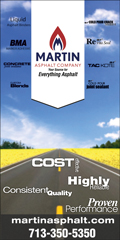| Thursday September 5 2013 | ||
 |
 |
 |
| Past Issues | www.texasasphalt.org | Printer-Friendly | Subscribe | Advertise |
NAPA Environmental Health and Safety Alert
Environmental, Health & Safety Alert
OSHA Releases Proposed Silica Standard
What It Means for the Asphalt Pavement Industry
Decades in the making, the Occupational Safety and Health Administration (OSHA) released on August 23, 2013, a massive 750-page proposed rule outlining a permissible exposure level (PEL) for silica dust. Although the proposed level is more stringent than the agency's current regulations, the asphalt industry is well positioned to meet the new standard thanks to the work of the Silica/Milling Machine Partnership. The OSHA website provides additional information on the proposal and rule making process at www.osha.gov/silica.
Details of the Standard
The proposed PEL for silica dust is now set at 50 micrograms of respirable crystalline silica per cubic meter of air (50 μg/m3). In the proposed rule, OSHA offers a "flexible alternative" compliance path for many construction operations, including roadway milling, that ensures compliance while waiving medical monitoring, exposure assessment, and other burdensome practices.
To take advantage of this alternative, specific practices outlined by OSHA must be followed. Under the flexible alternative for roadway milling, so long as milling machines "use [a] water-fed system that delivers water continuously at the cut point to suppress dust [and] operate equipment such that no visible dust is emitted from the drum box and conveyor areas," employees working on or near milling machines for less than four hours a day need no additional protection. For work shifts longer than 4 hours, however, the proposed rule requires half-mask respiratory protection.
For individuals who may visit a milling site or process for less than 4 hours per day, there appear to be no further personal protective equipment (PPE) requirements under the proposed rule's flexible alternative. Furthermore, for those operating equipment that supports the milling process, even on job shifts that last longer than 4 hours, no special protection is required so long as employees are in equipment with an enclosed, positive-pressure cab.
The Partnership
Over the past decade, the Silica/Milling Machine Partnership -- which is made up of the NAPA, AEM, milling-machine manufacturers, labor, academia, and NIOSH -- has worked to identify engineering controls and best practices that effectively reduce potential silica exposure below OSHA's new proposed PEL. The early work involving redesign of water spray systems within the cutter housing conducted by the Partnership was instrumental in helping the asphalt pavement industry avoid the more onerous compliance standards other industries face under the proposed rule. Current research by the Partnership is examining the use of evacuation systems to further reduce dust and potential silica exposure.
Impact of the Rule on the Asphalt Pavement Industry
As with all occupational health standards enforced by OSHA, there is an affirmative duty to ensure workers are protected from exposure to hazardous conditions, including potential emissions from various practices and processes. The proposed Silica Standard requires employers to understand work practices that have the potential for silica exposure, including milling, stock-pile management, baghouse inspection, and other common plant and paving activities. In general, OSHA identifies potential silica exposure in many construction and other industrial activities, and the agency has identified compliant operations and strategies that mitigate exposure to silica, e.g., use of milling machines with spray systems, as well as flexible alternative compliance paths.
Production Facility
General processing and workplace activities associated with asphalt pavement production facilities are not specifically identified in the proposed Silica Standard. However, the proposed Standard would require a preliminary characterization and assessment of potential silica exposure based on a "competent" understanding of process and equipment emissions. This could be accomplished through a company monitoring its individual employees or through a more general or "representative" exposure characterization that would need to be developed by industry and possibly reviewed by OSHA. Although general activities associated with asphalt pavement production and plant processing are not specifically identified by OSHA as a concern with regards to potential silica exposure, the agency has identified that, for example, rock crushing operations, under the proposed rule, would require very specific control mechanisms, including worker use of respiratory protection at all times.
Paving/Milling
OSHA does recognize the potential for occupational exposure of silica during roadway milling operations. As noted above, the proposed standard requires milling machines to use water-spray systems to minimize dust and requires respiratory protection for workers if their work shift is longer than 4 hours. Because of the issues associated with implementing a facility-specific respiratory protection program, NIOSH is currently completing field testing of evacuation system technologies through the industry Partnership NAPA and the Silica/Milling Machine Partnership intend to submit formal comments and statements during the rule making process to address concerns associated with the need for respiratory protection. The evacuation systems are demonstrating an ability to protect workers well below the proposed Standard.
Milling Machine Manufacturing
The Silica/Milling Machine Partnership is open to all companies involved with the manufacture of milling machines. Working closely with NIOSH over the past decade, the Partnership has made great strides in understanding processes that can be used to reduce dust and potential silica exposure. In 2010, the Partnership, in conjunction with OSHA, conducted a number of field trials to understand the efficacy of various water-spray systems that could easily be retrofitted onto existing equipment. More recently, equipment manufacturers have investigated the use of evacuation systems to capture and remove the majority of dust associated with milling operations from the worker's environment. Milling machine manufacturers are encouraged to continue working closely with the Partnership to ensure that potential silica exposure is reduced to the lowest point feasible, eliminating the need for respiratory protection.
Industry Path Forward
OSHA's acknowledgement that potential silica exposure can be controlled through simple milling machine spray-system retrofits illustrates the Silica/Milling Machine Partnership's early success. However, NAPA envisions a final Silica Standard that recognizes the use of water spray-system technologies and evacuation system technologies as sufficiently protective to remove the respiratory protection requirements in the proposed rule. OSHA has set out a detailed plan for formal comments and public hearings over the coming months.
During this rule making process, the Partnership plans to highlight the industry's commitment to ensuring that potential silica exposure is well-controlled and that silica exposure falls below any level of potential hazard. The Partnership plans to demonstrate to OSHA that current and future milling machine engineering controls work well to reduce potential exposure to silica dust below the proposed PEL thereby nullifying the need for respiratory protection. Throughout the Partnership's 10-year learning and development process, NIOSH has conducted and analyzed all test samples. The industry is well-positioned for a credible approach to protecting our workers.
NAPA, along with other industry groups, is further analyzing the potential impact of the proposed Silica Standard on operations that are ancillary to the production of asphalt pavement, including rock crushing and mining operations. NAPA intends to be involved with other associations during the rule making process as appropriate.
Summary
OSHA's release of their proposed Silica Standard, the first occupational exposure standard from the agency in decades, includes a flexible alternative compliance path for roadway milling operations that exempts those operations from some burdensome regulations. However, the proposed rule requires the use of respiratory protection requirement on work shifts longer than 4 hours during milling operations.
NAPA, as a leader of the Silica/Milling Machine Partnership, will take an active role in OSHA's rulemaking process with the goal of removing any respiratory protection requirement for roadway milling operations through the use of currently demonstrated engineering controls and best practices. NAPA may also work with other industry consortia during the rulemaking process to address proposed requirements associated with activities ancillary to asphalt pavement production, including the processing of aggregates.
|
Asphalt: Smooth | Durable | Quiet | Safe





